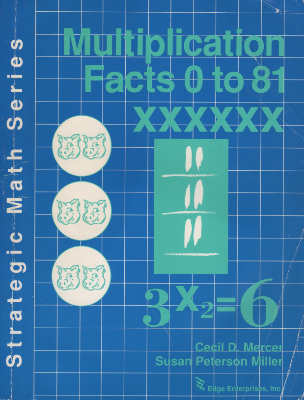Strategic Math: Multiplication Facts 0 to 81

The Strategic Math Series focuses on how to teach basic math facts and operations to students of any age. Content is built upon the concrete-representational-abstract method of instruction. In this approach, understanding of mathematics is developed through the use of concrete objects, representational drawings, and an easy-to-learn strategy that turns all students into active problem solvers.
Multiplication Facts 0 to 81 provides all of the materials you need to teach multiplication facts using the concrete-representational-abstract method of instruction. The manual outlines specific teaching procedures for each lesson and includes student tests, progress charts, practice sheets, and more.
In studies, computation scores of students with learning disabilities rose from a pretest mean of 45 percent to a posttest mean of 92 percent. In addition, their speed in making these calculations increased 400 percent. Their mean posttest scores were computer problems-92 percent; word problems without extraneous information-100 percent; word problems with extraneous information-92 percent; and creation of word problems-71 percent.
Author(s): Cecil D. Mercer, Susan Peterson Miller
Publication and Purchasing Information: University of Kansas, Center for Research on Learning / KU CRL Online Store
Resources:
Research Articles:
- Miller, S. P., Harris, C. A., Strawser, S., Jones, W. P., & Mercer, C. D. (1998). Teaching Multiplication to Second Graders in Inclusive Settings. Focus on Learning Problems in Mathematics, 20(4), 50-70. ERIC Number: EJ590274
- Morin, V. A., & Miller, S. P. (1998). Teaching multiplication to middle school students with mental retardation. Education and treatment of children, 22-36. https://www.jstor.org/stable/42899519
- Mercer, C. D., & Miller, S. P. (1992). Teaching students with learning problems in math to acquire, understand, and apply basic math facts. Remedial and Special Education, 13(3), 19-35.
https://doi.org/10.1177/074193259201300303
- Related Article:
- Bouck, E. C., Satsangi, R. & Park, J. (2017). The Concrete-Representational-Abstract Approach for students With learning disabilities: An evidence-based practice synthesis. Remedial and Special Education, 39(4) Summary: As researchers and practitioners have increasingly become interested in what practices are evidence based and for whom in education, different sets of quality indicators and evidence-based practice standards have emerged in the field of special education. Practices are commonly suggested as evidence based, even without a best evidence synthesis on the existing research, such as the case with the concrete–representational–abstract (CRA) instructional framework to support students with disabilities in mathematics. This study sought to support the classification of the CRA instructional framework as an evidence-based approach for students with learning disabilities by applying quality indicators and standards of evidence-based practice by Cook et al. (2014). Based on the application of the indicators and standards, the CRA instructional framework was determined to be an evidence-based practice for students with learning disabilities who struggle in mathematics relative to computational problems, such as addition, subtraction, and multiplication, largely with regrouping.
This product is available through the KUCRL Shop.
Please note that professional development, coaching, and infrastructure support are essential components to effective implementation of SIM instructional tools and interventions. It is highly recommended that you work with a SIM professional developer. See the SIM Event list for sessions or email simpd@ku.edu to learn more.
More in the Strategic Math Series
An accessible version of the documents on this site will be made available upon request. Please contact the KU CRL Professional Development Research Institute, at simpd@ku.edu to request the document be made available in an accessible format.